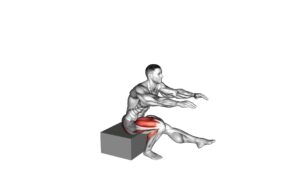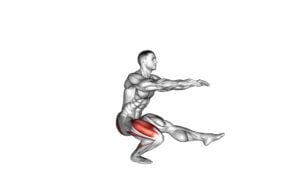One Leg Squat – Video Exercise Guide & Tips

Are you looking to take your leg workout to the next level? Then the one leg squat is the exercise for you. In this video exercise guide, we'll show you the proper form and technique to perform this challenging move.
Watch This Exercise Video
Whether you're a beginner or advanced fitness enthusiast, we've got modifications to suit your fitness level. Avoid common mistakes and get the most out of your workout with our expert tips.
Get ready to strengthen and tone your legs like never before.
Key Takeaways
- One leg squats improve balance and stability.
- They strengthen glutes, quadriceps, and hamstrings.
- One leg squats are essential for daily activities like walking and climbing stairs.
- They are highly effective in targeting lower body muscles.
Benefits of the One Leg Squat
You can experience several benefits by incorporating the one leg squat into your workout routine. This exercise isn't only challenging but also highly effective in targeting your lower body muscles.
One of the main benefits of the one leg squat is its ability to improve your balance and stability. By performing this exercise on one leg, you engage your core muscles, which play a crucial role in maintaining balance. Additionally, the one leg squat helps to strengthen your glutes, quadriceps, and hamstrings, which are essential for daily activities such as walking, running, and climbing stairs.
Another benefit of the one leg squat is its versatility. It can be modified to suit different fitness levels and goals. If you're a beginner or have limited strength, you can start with a regression, such as using a support or performing the exercise with a shorter range of motion. As you progress, you can increase the difficulty by incorporating progressions, such as adding weights or performing the exercise on an unstable surface.
Incorporating alternative exercises, progressions, and regressions into your workout routine can help prevent plateaus and keep your workouts challenging and effective. The one leg squat is a great addition to your routine as it offers numerous benefits and can be adjusted to meet your individual needs.
Proper Form and Technique
To perform the one leg squat with proper form and technique, focus on maintaining a stable core and controlled movement throughout the exercise. This will help you engage the correct muscles and prevent any unnecessary strain or injury.
Start by standing on one leg, with your other leg slightly lifted off the ground. Keep your chest up and shoulders back, as this will help maintain proper posture throughout the movement.
As you begin to squat down, hinge at your hip and push your hips back, while keeping your knee in line with your toes. It's important to lower yourself as far as you can comfortably go, while maintaining control and balance.
To add variation to your one leg squat routine, you can try different foot positions, such as placing your foot on a step or using a stability ball. These variations will challenge your balance and stability even further.
For those looking for advanced one leg squat progressions, you can incorporate weights by holding a dumbbell or kettlebell at your chest or by using a resistance band for added resistance.
Remember to always listen to your body and progress at a pace that's comfortable for you. With proper form and technique, the one leg squat can be a highly effective exercise for strengthening your lower body and improving your stability and balance.
Modifications for Different Fitness Levels
To modify the one leg squat for different fitness levels, incorporate variations that cater to individual strength and balance abilities.
There are several progression options that can be used to modify the one leg squat based on your fitness level.
For beginners or those with limited strength and balance, it's recommended to start with a supported one leg squat. This can be done by holding onto a stable surface, such as a wall or chair, for support while performing the squat.
As you progress and gain strength, you can gradually decrease the amount of support until you're able to perform the squat without any assistance.
For intermediate and advanced fitness levels, you can increase the difficulty of the one leg squat by adding weight. This can be done by holding a dumbbell or kettlebell in your hands, or by wearing a weighted vest. Adding weight will challenge your muscles and help to further develop strength and stability.
In terms of equipment recommendations, it's beneficial to have a stable surface, such as a step or bench, to provide support and assist with balance during the one leg squat. Additionally, using a mirror or having a training partner to provide feedback on your form can be helpful to ensure proper technique.
By incorporating these modifications and progression options, you can tailor the one leg squat to your individual fitness level and continue to challenge yourself as you improve.
Now, let's move on to the next section and discuss some common mistakes to avoid when performing the one leg squat.
Common Mistakes to Avoid
When performing the one leg squat, it's important to be aware of common mistakes that can hinder your form and potentially lead to injury. By understanding these mistakes, you can take steps to avoid them and improve the effectiveness of this exercise.
One common mistake isn't maintaining proper alignment. It's crucial to keep your knee in line with your toes and avoid letting it collapse inward or outward.
Another mistake isn't going through the full range of motion. Make sure to lower yourself as far as you can while maintaining control and stability.
Additionally, rushing through the exercise can compromise your form. Take your time and focus on performing each repetition with control and precision.
Lastly, neglecting progressions and regressions is a mistake that can hinder your overall progress. If the one leg squat is too challenging, try starting with a supported variation or using a resistance band for assistance. On the other hand, if it becomes too easy, consider adding weight or performing the exercise on an unstable surface to further challenge yourself.
Tips for a Safe and Effective Workout
Ensure a safe and effective workout by incorporating these tips into your one leg squat routine.
Before you begin any exercise, it's crucial to warm up your body. A proper warm-up increases blood flow to your muscles, prepares your joints for movement, and helps prevent injuries. Spend 5-10 minutes doing light cardio exercises like jogging or jumping jacks, followed by dynamic stretches that target the lower body, such as leg swings and hip circles.
After your workout, don't forget to cool down. Cooling down allows your heart rate and breathing to gradually return to normal and helps prevent muscle soreness. Take 5-10 minutes to perform static stretches for your legs, hips, and lower back. This will help improve flexibility and reduce the risk of muscle imbalances.
To maximize the benefits of your one leg squat routine, consider incorporating it into a full body workout. This will ensure that you're targeting all major muscle groups and promoting overall strength and stability. For example, you can pair one leg squats with exercises like push-ups, rows, and planks to engage your upper body and core.
Frequently Asked Questions
How Many Repetitions Should I Do When Performing the One Leg Squat?
When performing the one leg squat, it's important to determine the right number of repetitions for you. Start with a lower number, like 5-10, and gradually increase as you improve form and strength.
This exercise can be challenging, so listen to your body and avoid common mistakes like leaning too far forward or not going low enough.
Can the One Leg Squat Help Improve Balance and Stability?
Incorporating one leg squats into your daily workout routine can greatly improve balance and stability. By challenging your body to maintain proper form on one leg, you activate muscles in your core, hips, and lower body that are essential for balance.
This exercise also helps to strengthen the muscles around your knees, reducing the risk of injury. To progress and modify the one leg squat for different fitness levels, you can use a support like a chair or gradually increase the depth of the squat.
Is It Necessary to Warm up Before Attempting the One Leg Squat?
Before attempting the one leg squat, it's crucial to warm up your muscles. This helps prepare your body for the exercise and reduces the risk of injury.
Proper form is important in the one leg squat to ensure maximum effectiveness and prevent strain on your joints. Common mistakes to avoid include leaning too far forward, not engaging your core, and letting your knee cave in.
Can the One Leg Squat Help With Strengthening the Muscles in the Lower Body?
The one leg squat is a great exercise for strengthening the muscles in your lower body. It can help improve mobility and provide numerous benefits for athletes.
By focusing on one leg at a time, you're able to target and engage specific muscles like your quadriceps, glutes, and hamstrings. This exercise challenges your balance and stability, which can lead to improved athletic performance.
Incorporating the one leg squat into your workout routine can help you build strength and power in your lower body.
Are There Any Variations of the One Leg Squat That Can Be Performed With Equipment or Weights?
There are indeed various variations of the one leg squat that can be performed with equipment or weights. These modifications can help you increase the intensity and challenge your lower body muscles even further.
By incorporating equipment such as resistance bands, dumbbells, or kettlebells, you can add resistance to the exercise and stimulate muscle growth.
Additionally, using weights during one leg squat progressions can enhance stability and balance while strengthening your leg muscles.
Conclusion
In conclusion, the one leg squat is a highly effective exercise that offers numerous benefits, including improved balance, strength, and stability.
By following proper form and technique, and making modifications based on your fitness level, you can perform this exercise safely and effectively.
Avoiding common mistakes and incorporating the provided tips will further enhance your workout experience.
Incorporate the one leg squat into your fitness routine to challenge your lower body muscles and take your fitness to the next level.

Author
Years ago, the spark of my life’s passion ignited in my mind the moment I stepped into the local gym for the first time. The inaugural bead of perspiration, the initial endeavor, the very first surge of endorphins, and a sense of pride that washed over me post-workout marked the beginning of my deep-seated interest in strength sports, fitness, and sports nutrition. This very curiosity blossomed rapidly into a profound fascination, propelling me to earn a Master’s degree in Physical Education from the Academy of Physical Education in Krakow, followed by a Sports Manager diploma from the Jagiellonian University. My journey of growth led me to gain more specialized qualifications, such as being a certified personal trainer with a focus on sports dietetics, a lifeguard, and an instructor for wellness and corrective gymnastics. Theoretical knowledge paired seamlessly with practical experience, reinforcing my belief that the transformation of individuals under my guidance was also a reflection of my personal growth. This belief holds true even today. Each day, I strive to push the boundaries and explore new realms. These realms gently elevate me to greater heights. The unique combination of passion for my field and the continuous quest for growth fuels my drive to break new ground.



